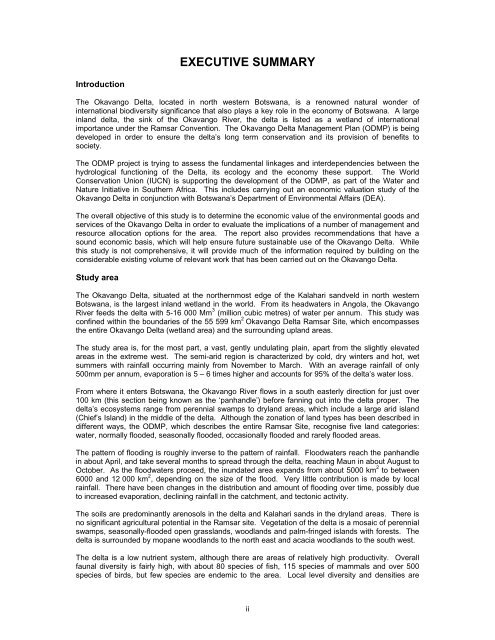Download PDF - Anchor Environmental
Download PDF - Anchor Environmental
Download PDF - Anchor Environmental
Create successful ePaper yourself
Turn your PDF publications into a flip-book with our unique Google optimized e-Paper software.
EXECUTIVE SUMMARY<br />
Introduction<br />
The Okavango Delta, located in north western Botswana, is a renowned natural wonder of<br />
international biodiversity significance that also plays a key role in the economy of Botswana. A large<br />
inland delta, the sink of the Okavango River, the delta is listed as a wetland of international<br />
importance under the Ramsar Convention. The Okavango Delta Management Plan (ODMP) is being<br />
developed in order to ensure the delta’s long term conservation and its provision of benefits to<br />
society.<br />
The ODMP project is trying to assess the fundamental linkages and interdependencies between the<br />
hydrological functioning of the Delta, its ecology and the economy these support. The World<br />
Conservation Union (IUCN) is supporting the development of the ODMP, as part of the Water and<br />
Nature Initiative in Southern Africa. This includes carrying out an economic valuation study of the<br />
Okavango Delta in conjunction with Botswana’s Department of <strong>Environmental</strong> Affairs (DEA).<br />
The overall objective of this study is to determine the economic value of the environmental goods and<br />
services of the Okavango Delta in order to evaluate the implications of a number of management and<br />
resource allocation options for the area. The report also provides recommendations that have a<br />
sound economic basis, which will help ensure future sustainable use of the Okavango Delta. While<br />
this study is not comprehensive, it will provide much of the information required by building on the<br />
considerable existing volume of relevant work that has been carried out on the Okavango Delta.<br />
Study area<br />
The Okavango Delta, situated at the northernmost edge of the Kalahari sandveld in north western<br />
Botswana, is the largest inland wetland in the world. From its headwaters in Angola, the Okavango<br />
River feeds the delta with 5-16 000 Mm 3 (million cubic metres) of water per annum. This study was<br />
confined within the boundaries of the 55 599 km 2 Okavango Delta Ramsar Site, which encompasses<br />
the entire Okavango Delta (wetland area) and the surrounding upland areas.<br />
The study area is, for the most part, a vast, gently undulating plain, apart from the slightly elevated<br />
areas in the extreme west. The semi-arid region is characterized by cold, dry winters and hot, wet<br />
summers with rainfall occurring mainly from November to March. With an average rainfall of only<br />
500mm per annum, evaporation is 5 – 6 times higher and accounts for 95% of the delta’s water loss.<br />
From where it enters Botswana, the Okavango River flows in a south easterly direction for just over<br />
100 km (this section being known as the ‘panhandle’) before fanning out into the delta proper. The<br />
delta’s ecosystems range from perennial swamps to dryland areas, which include a large arid island<br />
(Chief’s Island) in the middle of the delta. Although the zonation of land types has been described in<br />
different ways, the ODMP, which describes the entire Ramsar Site, recognise five land categories:<br />
water, normally flooded, seasonally flooded, occasionally flooded and rarely flooded areas.<br />
The pattern of flooding is roughly inverse to the pattern of rainfall. Floodwaters reach the panhandle<br />
in about April, and take several months to spread through the delta, reaching Maun in about August to<br />
October. As the floodwaters proceed, the inundated area expands from about 5000 km 2 to between<br />
6000 and 12 000 km 2 , depending on the size of the flood. Very little contribution is made by local<br />
rainfall. There have been changes in the distribution and amount of flooding over time, possibly due<br />
to increased evaporation, declining rainfall in the catchment, and tectonic activity.<br />
The soils are predominantly arenosols in the delta and Kalahari sands in the dryland areas. There is<br />
no significant agricultural potential in the Ramsar site. Vegetation of the delta is a mosaic of perennial<br />
swamps, seasonally-flooded open grasslands, woodlands and palm-fringed islands with forests. The<br />
delta is surrounded by mopane woodlands to the north east and acacia woodlands to the south west.<br />
The delta is a low nutrient system, although there are areas of relatively high productivity. Overall<br />
faunal diversity is fairly high, with about 80 species of fish, 115 species of mammals and over 500<br />
species of birds, but few species are endemic to the area. Local level diversity and densities are<br />
ii
















